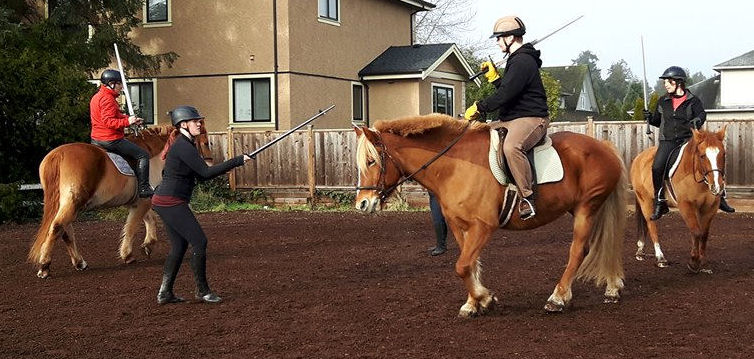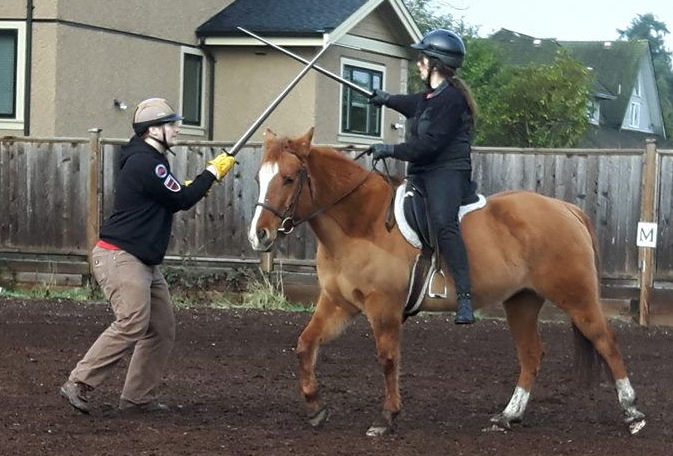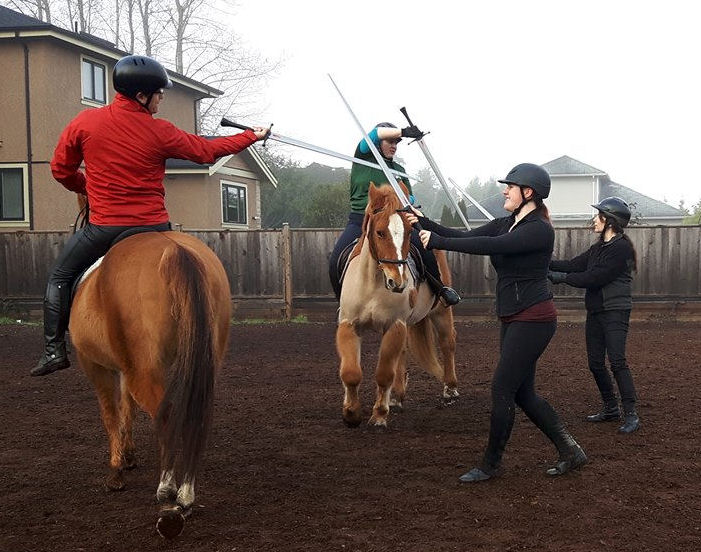Red Spur Swordplay from the Ground
Last week we looked at the general advantages and disadvantages the combatant on the ground faces when up against a rider. This week I'll get a little more specific and give you some plays you can use. This is a sample only, not an all-encompassing toolbox of tactics, but it should give you a starting place to develop your own plays.

Plays from the Ground against the Mounted Opponent
For simplicity of direction, these directions assume both players are right-handed and are engaging on the right side of the horse.
Receiving the thrust
- As the rider moves towards you in a straight line, with her sword presented for a thrust, find her on the outside in posta longa. Transition to posta breve as the rider continues to move forward and brace as you suppress her sword on the outside. Your target will be the rider's thigh, hip, or flank, depending on the height of the horse.
- If the rider disengages to the inside, follow with a volta stabile of the sword and pivot left as you come into breve, so that you are facing the horse's side. In this instance, your thrust will finish in the back of the knee, buttock, or lower back of the rider.
- In either case above, if the rider turns her horse towards you, continue to step left and come into posta frontale to dominate the space between the horse's head and the rider (from here you are likely to come into grappling territory ... a topic for another time).
Receiving the mandritto fendente

- From posta longa, disengage and step left; finish as in receiving the thrust, above.
- From any guard, collect the sword in posta frontale and riposte with a thrust, turning to posta finestra sinestra to protect your head. (Note: do not be tempted to expel the sword downward as you might when facing an opponent on the ground -- you won't be able to expel it far enough to keep yourself safe).
- From posta di donna or porta di ferro, parry with a half-cut, keeping the point high, and step left, riposting as in receiving the thrust, above.
- From posta di donna sinestra or dente al cinghiare, deflect and step left; riposte with a mandritto to arm, hip, or flank, or a thrust from posta finestra. Keep the deflection high to avoid hitting the horse.
Receiving the roverso fendente
- From posta longa, collect the sword and finish in breve as in receiving the thrust, above.
- From posta di donna sinestra or dente al cinghiare parry the roverso and riposte with a cut or thrust in falso to the arm or torso. Direct your parry upward to prevent driving the swords into the horse. A counter-cut to the arm also works well here.
- From posta di donna or porta di ferro, step left and parry the roverso. Deflecting the roverso is dangerous against a rider as it will leave the opponent's sword in front of your face.
- From any guard, collect or counter-thrust in posta finestra.
This is just a sample of plays in which the person on the ground is receiving the blow. You can create just as many in which the rider is receiving, and you can experiment with engaging on the rider's left side, which is a different kettle of fish altogether.
General tactics
You will notice that some actions keep cropping up: stepping to the left, collecting, and thrusts.
- Stepping or turning left allows access to your opponent's back and flank, as well as their outside line. Because the horse's neck is in the way, the rider cannot yield when her sword is trapped on the outside, so she is limited to disengaging under or turning her mount to regain control of the line.
- Collecting the blow is often the safest way of containing and limiting the speed and power of a cut thrown from a moving horse. Because the rider is taller than you, deflections and parries often do not take your opponent's sword very far away from your head, which fails to give you the tempo you need to riposte and defend against their next blow.
- The thrust is often the best counter-attack or riposte for the same reason that collection is the best defence. A thrust allows you to attack without leaving your opponent's sword or uncovering your line of defence, and uses your opponent's momentum against her. That said, there are tournament formats which disallow thrusts for horse and rider safety, so practice attacking with cuts as well.
Things to keep in mind
- Attacks against the horse. In historical warfare, attacks against horses were fair game. Yes, horses were valuable, but your own life was moreso if it came down to that. However, in our modern, friendly context attacks to the horse are prohibited, and we won't ask you to demonstrate them, even in theory.
- Accidental hits to the horse. To avoid accidental hits, be mindful of your targets. Direct parries and deflections upward, and keep a soft, responsive hand. Couched thrusts should be released as soon as they make contact (this is kind to your human partners as well).
- Keep moving. A common error is becoming fixed and allowing the horse and rider to dominate the space. Use your bipedal agility to keep changing the angle and measure of the engagement to your advantage.
- Treat the horse as dangerous. Our horses are extremely cuddly and most wouldn't dream of hurting you. However, a true warhorse might be trained to attack by charging, kicking, or striking. Following our tenet of 'proper respect', imagine that crossing directly behind or in front of the horse could be hazardous to your survival.
Upcoming Classes
By coincidence (or is it conspiracy?) the focus of this month's Mounted Combat Mastery classes is ground vs mounted combat. If you are on a tuition program you can use your credit to drop in to these classes, every Sunday from noon - 2pm. Don't know how to ride? No problem. Classes can be taken from the ground as well as from horseback, and this month in particular we need an assortment of students in both categories. And, as you can tell from the smiles on our faces, its loads of fun!
Mounted Combat Mastery
Sundays noon - 2pm
Instructor: Jennifer Landels
cost: 2-hour tuition or punch card credit
Riding, Horsemanship, and Mounted Combat Fundamentals series all started up last week. However, it's not too late to join in the class. Call up the front desk at 604 568 9907 to see if there is space for you.
Mounted Combat Fundamentals
Before you get on a horse with a sword in your hand, it is essential to have good fundamental swordplay skills from the ground. This six-week course covers the basic Mounted Combat skills needed for your Green Spur. Students who have achieved these skills along with Riding and Horsemanship Level 1 will be eligible to participate in Mounted Combat classes on horseback.
Sundays 21 January – 25 February, 1:00pm – 3:00pm
Cost: $135 + gst, or bundle with Riding & Horsemanship for $99
Instructor: Ben Davis
Prerequisites: none
Beginner Riding & Horsemanship
This six-class course is designed to help the beginning rider achieve Horsemanship and Riding Level 1. In addition to your weekly riding lesson, you will learn safe horse-handling techniques, how to groom and tack up a horse, basic horse identification terminology, and basic feeding and stabling. The cost of the course includes one free riding or horsemanship assessment. Students can expect to be ready to assess Horsemanship Level 1 at the end of the six classes. Readiness for Riding Level 1 typically takes two iterations of the course.
Sundays 21 January – 25 February, 11:00am – 1:00pm
Cost: $300 + gst
Instructor: Stephanie Laversin
Prerequisites: none
Riding & Horsemanship Level 2
This six-class course is designed to help the riders achieve Horsemanship and Riding Level 2. The cost of the course includes one free riding or horsemanship assessment. Students can expect to be ready to assess Horsemanship Level 2 at the end of the six classes. Readiness for Riding Level 2 typically takes two iterations of the course.
Sundays 21 January – 25 February, 10:00am – noon
Cost: $300 + gst
Instructor: Stephanie Laversin
Prerequisites: Beginner Riding & Horsemanship
Riding Level 3+, Flat
A six-class series for riders working on Level 3 or higher with an emphasis on flat-work and lower level dressage. Some ground poles and cavaletti may be included. (Note: Riding Level 3, Jumping will begin in March).
Sundays 21 January – 25 February, 10:00am – 11:00am
Cost: $200 + gst
single classes: $45 each if space available
Instructor: Stephanie Laversin
Prerequisites: Riding Level 2
Youth Riding & Horsemanship
This course for kids aged 6-13 will introduce your child to ponies and horses in safe, fun, and friendly series of six classes taught by Pony Club qualified instructors. Each class contains a riding lesson as well as a horsemanship lesson where students will learn to handle, groom, and care for ponies and horses. Curriculum follows the Canadian Pony Club D level lessons and will prepare students for testing Academie Duello Mounted Combat Riding 1 or Pony Club D Level.
Thursdays 1 February – 8 March, 4:00pm – 6:00pm
Cost: $300 + gst
Instructor: Kate Landels
Prerequisites: none
To register see the Workshops Calendar or call the front desk at 604 568 9907.
